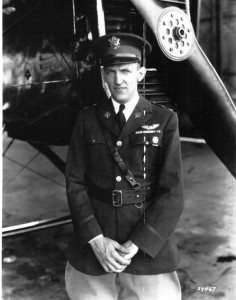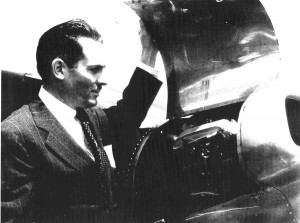By Henry M. Holden
On May 24, the New Jersey Aviation Hall of Fame held its 33rd annual induction dinner. The 2006 inductees were James O. Plinton Jr., George A. Vaughn Jr., Donald A. Luscombe and Lowell E. White. Dr. Greg Olsen was the keynote speaker.
James O. Plinton Jr. (1914-1996)

James O. Plinton Jr. was one of the first African-Americans to teach the Tuskegee Airmen to fly. The “Red-Tail Devils,” a nickname given to the Tuskegee Airmen of the 99th Pursuit Squadron, never lost a bomber under their protection.
James O. Plinton Jr. was one of the first African-Americans to be named an executive in the airline industry.The Westfield, N.J. native graduated from Lincoln University in Pennsylvania in the mid-1930s, then entered the University of Newark’s Division of Aeronautics, earning a commercial pilot’s license and flight instructor’s rating. At the outbreak of World War II, he joined the U.S. Army Air Corps flight training staff as one of the first African-American flight instructors of the 99th Pursuit Squadron at the Tuskegee Institute in Alabama. He taught 150 Tuskegee airmen to fly.
After the war, and many attempts to become a pilot with the major airlines, which at the time had strong biases against hiring African-Americans, Plinton helped organize the Equadronian airline Andesa and later the Haitian International Airline. He returned to the United States in 1957, and joined Trans World Airlines as an executive assistant to the director of personnel and industrial relations. He called the industry breakthough for African-Americans a “fabulous opportunity.”
In 1971, he moved to Eastern Airlines as a vice president, then the highest position of achieved by an African-American. When he retired in 1980, former astronaut Frank Borman, then chairman of Eastern Airlines, asked him to stay as a special assistant for one year.
George A. Vaughn Jr. (1892-1984)

George A. Vaughn Jr. shot down 13 enemy aircraft during World War I. He became the second highest ranking American ace of that war. Captain Eddie Rickenbacker was the first.
George A. Vaughn Jr. was one of the greatest aces of the American Expeditionary Force in World War I. When America entered the war, he left school and enlisted in the fledgling aviation section of the U.S. Army Signal Corps. He completed flight training in a Royal Flying Corps school in England, and in May 1918, entered combat with the 84th Squadron, RFC. His tour with the British was designed to gain fighter experience before joining the American squadrons, then forming in France.
In three months, Vaughn downed six planes and an observation balloon and received the British Distinguished Flying Cross. In August, he transferred to the U.S. Air Service as a flight commander of the 17th Aero Squadron, flying the British-built Sopwith Camel. In less than two months, he shot down six more aircraft and became an ace in both the Royal Air Force and the U.S. Air Service.
After the war, he completed his engineering degree at Princeton and gained practical experience as an engineer. In 1928, he founded the Eastern Aeronautical Corporation (later General Aviation Company), which was the first company to build a hangar at Newark Airport.
In 1932, Vaughn, Charles “Casey” Jones and Lee Warrener formed the Casey Jones School of Aeronautics in Newark, N.J. When LaGuardia Airport opened in 1939, a branch of the school moved to Flushing, N.Y., and was named the Academy of Aeronautics. During World War II, both schools combined taught more than 36,000 aviation technicians. In 2005, the Flushing academy was renamed the Vaughn College of Aeronautics.
Donald A. Luscombe (1895-1965)
Donald A. Luscombe became fascinated with aviation during his service as an ambulance driver during World War I, when he hitched rides with French pilots who were ferrying airplanes between bases. After the war, he bought a surplus JN-4, and learned to fly.
Luscombe soon become know as an innovative aircraft designer and builder. He founded the Luscombe Aircraft Company in 1926, in Kansas City, Mo. His company’s first airplane was the Luscombe Model 1, commonly known as the Luscombe Phantom, a high-wing, two-place monoplane of all-metal construction (except for the fabric wing covering). The Phantom was expensive ($6,000), tricky to land and was never a financial success, due in part, to the Depression.
In the winter of 1934-1935, the Luscombe Aircraft Company moved to Mercer County Airport, West Trenton, N.J., and was incorporated as the Luscombe Aircraft Development Corporation. Luscombe organized the plant on a production line similar to the automobile manufacturers. Within six months he was able to produce a fuselage, and was soon manufacturing eight completed airplanes a week. Soon afterwards, he opened the Luscombe School of Aeronautics to create a source of qualified workers.
The Luscombe Model 8 Silvaire was to become the company’s most famous product. The sleek aluminum aircraft, built in 1938, sold for $1,895. By years-end, 230 were flying. That year, the company reported a gross income of more that $450,000. Working at full capacity the plant produced 32 aircraft a month.
In 1939, Luscombe sold his shares in the company and retired at the age of 44, to his farm in Pennsylvania.
Lowell E. White (1906-1995)

Lowell E. White and his company had a superlative safety record, teaching more than 45,000 hours without a single injury. He was instrumental in organizing the Civil Air Patrol in New Jersey in 1940.
Lowell E. White came to New Jersey in 1930 as the chief pilot and operations manager of the Curtiss-Wright Flying Service, at Caldwell-Wright Airport, in Fairfield, N.J. He had held similar positions with White Mountain Airlines in Boston and the Curtiss Company in Maine. For the next three years, he flew 1,700 hours, instructing, flying cross-country charters, mapping and barnstorming.
Late in 1932, the Curtiss-Wright Flying Service discontinued its flight operations. White formed White Flying Service Corp., and assumed flight and aircraft sales at the airport until 1942. Over that 10-year period, his company taught more than 5,000 students to fly, with more than 45,000 hours in the air, without a single injury. White had joined the Air National Guard in 1938, but resigned in 1940 to work with the Civil Air Patrol training program.
Following the war, White was employed by the Eclipse Pioneer Division of Bendix Aviation Corporation, and was in charge of aircraft and flight operations. He was the test pilot for new instruments and accessories.
Keynote speaker
On Oct. 1, 2005, Dr. Greg Olsen launched on a Russian Soyuz rocket TMA-7. He docked at the International Space Station on October 3, and returned to Earth on October 11 on the Soyuz TMA-6, after 160 orbits of the Earth. He traveled over four million miles in space.
Olsen earned a PhD in material science from the University of Virginia in 1971. An American scientist, inventor and entrepreneur, he was inspired by the dawn of the space age, the promise of space exploration and the spectacular experiences of the space station’s first two private explorers, Dennis Tito in 2001, and Mark Shuttleworth in 2002. Olsen spoke of his training program, flight to MIR and the effects of weightlessness.
Olsen is now president of GHO Ventures, in Princeton, N.J., where he manages his angel investments, a South African winery and a Montana ranch. He speaks at numerous engagements and shares his experiences with school children, especially minorities and females, encouraging them to consider careers in science and engineering.
The New Jersey Aviation Hall of Fame

Keynote speaker Dr. Greg Olsen is only the third private citizen to travel into space. He uses his experience to encourage young people to consider careers in math and science.
The New Jersey Aviation Hall of Fame was founded in 1972, and was the first state aviation hall of fame in the nation. The goal of the annual dinners is the preservation of the state’s 212 years of aviation and space history.

The presentation of the Fred Wehran Award for distinguished service to aeronautics in New Jersey was presented to Jim Carroll (left) and Jim Barrett of Paramus Flying Club on the occasion of their “50 Years of Fostering Affordable Flying and Camaraderie.”












